The shortlisted artists for the Jameel Prize 2011
Jul 24, 2011 Awards
• Noor Ali Chagani
• Monir Shahroudy Farmanfarmaian
• Bita Ghezelayagh
• Babak Golkar
• Hayv Kahraman
• Aisha Khalid
• Rachid Koraïchi
• Hazem El Mestikawy
• Hadieh Shafie
• Soody Sharifi
Almost 200 nominations for the Jameel Prize 2011 were received, from countries as diverse as the United States, Spain, Nigeria, Egypt and Pakistan. A panel of judges, chaired by V&A Director, Sir Mark Jones, selected the shortlist of ten artists and designers. Mark Jones said: “The quality of the work shortlisted for this year’s Jameel Prize is outstanding. The output of the finalists is very varied, reflecting the richness and diversity of the Islamic traditions that inspired them. The work shows how complex and eloquent the art and design inspired by this tradition has become.â€
The works on show will range from felt costumes to sculpture made from hand-made terracotta bricks and from mirror mosaic to digital collages inspired by traditional Persian miniature paintings. In much of the work there is an underlying reference to the artists’ own ‘hybrid’ cultural identity; the mix of old and new, minimalism versus ornament, tradition and modernity, and home versus exile.
The winner of The Jameel Prize 2011 will be announced at the V&A on 12 September 2011. The Jameel Prize is a £25,000 international art prize for contemporary artists and designers inspired by Islamic traditions of craft and design. Launched in 2009, the winner of the first Jameel Prize was Afruz Amighi for her work 1001 Pages (2008), an intricate hand-cut screen made from the woven plastic used to construct refugee tents.
The Jameel Prize is sponsored by Abdul Latif Jameel Community Initiatives (ALJCI). The prize was conceived after the renovation of the V&A’s Jameel Gallery of Islamic Art, which opened in July 2006. The gallery is an outstanding presentation of the rich artistic heritage of the Islamic world, and the prize aims to raise awareness of the thriving interaction between contemporary practice and this great historical heritage. It has also contributed to a broader understanding of Islamic culture and its place in the world.
Award-winning architect Zaha Hadid is Patron of the Jameel Prize. She says: “It is a very exciting time for artists working in Islamic art tradition, there is a real spirit of innovation and creativity in the air. Their work now goes beyond established ainting, sculpture and calligraphy to explore new media and reflect the diverse cultures and histories of the region. This work has evolved with its own characteristic voice, exploring future possibilities, yet is derived from rich cultural traditions and a timeless history. For millennia, the Islamic arts and sciences have bridged the cultural divide between East and West, teaching us that these worlds are not mutually exclusive, but rather layered upon each other and profoundly interlinked. The Jameel Prize gives us a very promising outlook to the future and I am pleased to see the region’s artists pushing new boundaries.”
Wassan Al-Khudhairi, Director, Mathaf: Arab Museum of Modern Art, Qatar
Navid Akhtar, Executive Director, Gazelle Media
Afruz Amighi, artist and winner of the Jameel Prize 2009
Dina Bakhoum, Conservation Programme Manager, The Aga Khan Trust for Culture, Egypt
will show Life Line (2010) and Infinity (2009); two sculptural works made from miniature terracotta bricks. Chagani translates his training in the principles of Mughal miniature painting into sculpture by using miniature hand made bricks to imitate large building blocks. Both works refer to the fundamental desires of man to provide a house for shelter. The curves and movements of the bricks in Life Line are like a piece of cloth, serving as protection, as clothes provide a second skin, yet made of brittle and hard bricks they define the toughness and hardships of life’s daily struggle. Infinity continues Chagani’s interest with bricks creating the illusion of an endless series of walls each made from hundreds of handmade bricks. The work reflects a view of history, the broken walls and homes of an ancient civilisation and the endless hurdles and obstacles faced by man. Noor Ali Chagani was born, lives and works in Pakistan.
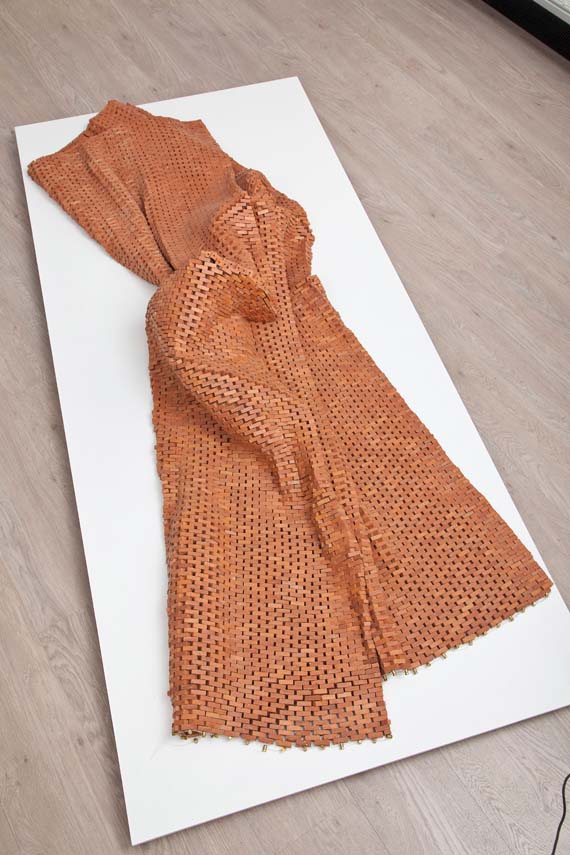
Life Line / 2010 / Courtesy of the artist and Green Cardamom
is one of Iran’s most celebrated artists with a career spanning more than five decades. She will exhibit Birds of Paradise (2008), a work that demonstrates her distinctive style of adapting and combining Iranian traditions of mirror mosaic and reverse glass painting techniques with a modern aesthetic. Mirrors are cut and set in geometric patterns and integrated with coloured glass, referencing a range of influences in Islamic art, architecture and science. This particular work is inspired by the many feathers left by sparrows on her balcony in Tehran. Monir Shahroudy Farmanfarmaian was born in Iran, spent many years in the USA, but currently lives and works in Tehran.
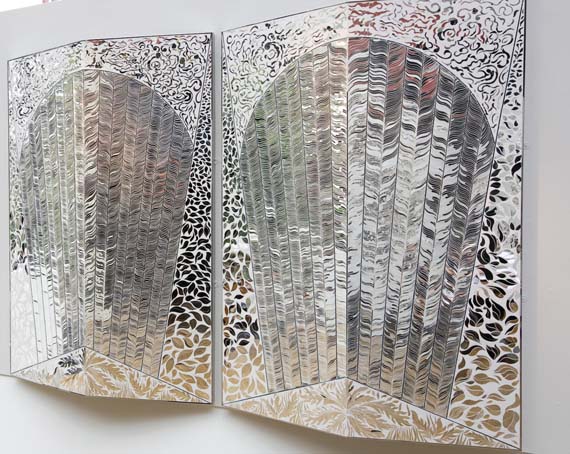
Birds of Paradise / 2008 / Courtesy of Rose Issa Projects
works in the traditional Iranian craft of felt-making. She will show three pieces from her Felt Memories series (2007-9), inspired by the Islamic tradition of talismanic coats, worn to protect the wearer from misfortune. Ghezelayagh uses metal keys, crowns, tulips (symbols of martyrdom), machine guns and other street symbols combined with printed Persian phrases to cover the surface of her pieces. The juxtaposition of urban imagery with a rural craft tradition creates a new visual language which embraces both tradition and modernity. Bita Ghezelayagh was born in Italy and now lives and works between London and Tehran.
Felt Memories III / 2008/9 / Courtesy of Rose Issa Projects
will show a new piece entitled Negotiating the Space for Possible Coexistences No.5 (2011). Golkar’s multi-disciplinary work often examines socio-cultural issues experienced from living in both the Middle East and Canada. This work is part of a series that uses the pattern of Persian carpets as a blue print for architectural scale models. The model sits on top of the carpet so that the relationship between the two forms is accessible to the viewer, creating a conceptual connection between the traditions of Modern and Postmodern architecture and the traditions of nomadic society. The work also challenges the spatial economies of the two traditions, offering a space for cross-cultural dialogue. Babak Golkar was born in the USA and now lives and works in Canada.
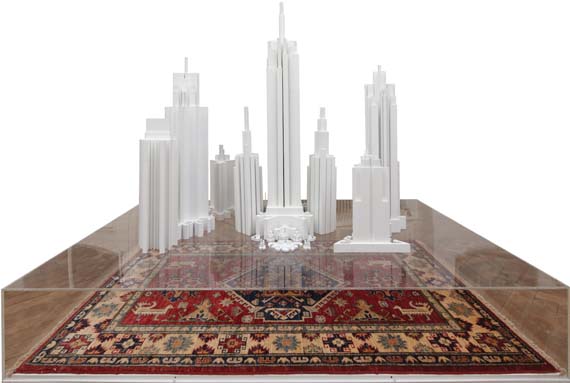
Negociating the Space for Possible Coexistences No.2 / 2009 / Courtesy of Collection SANZIANY @ A.Riklin-Foundation
will show two paintings from the Waraq series, Migrant 8 (2010) and Migrant 1(2010) and Asad Babil, a new work from a series based on Assyrian Lion Hunt relief sculptures. Kahraman’s work is inspired by her experience of living in Baghdad, Europe and the USA. Waraq means ‘playing cards’ in Arabic and references a popular Iraqi pastime. Kahraman has invented a suit of cards to explore the lives of people who personify the Iraqi Diaspora and their stories of assimilation, alienation and discovery in their new homes. The work also references the so called ‘Archaeology awareness playing cards’ - 40,000 decks of cards which were sent to American troops in Iraq and Afghanistan in 2007 to highlight important archaeological sites and to discourage illegal trade in artefacts. Asad Babil depicts an injured life-sized lion painted in Islamic geometric patterns and black and red paint. Instead of blood, a set of ‘diasporic’ playing cards gushes from the lion’s
mouth, referencing the fall of Iraq and the wounded people as its victims and prey. Hayv Kahraman was born in Iraq and now lives and works in the USA.
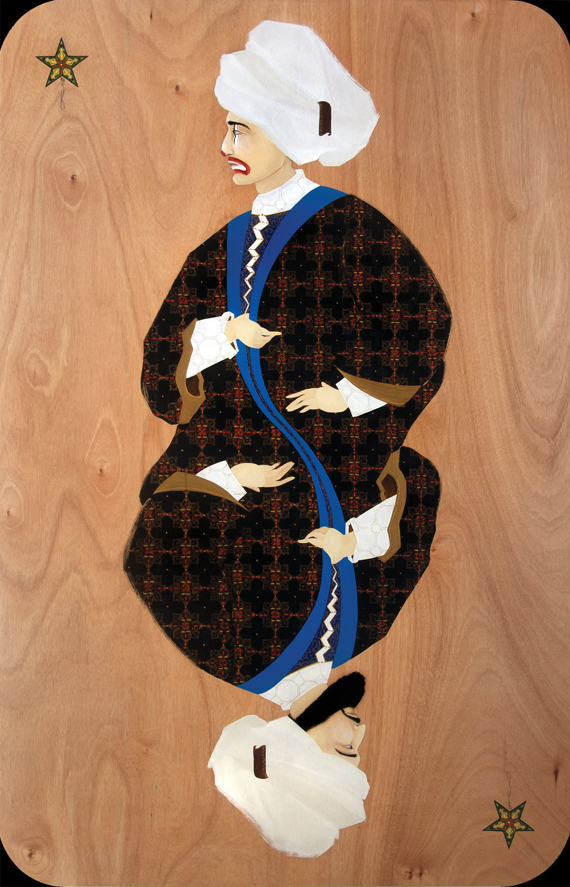
Migrant 8 / 2010 / Courtesy of the artist
will show Name, Class, Subject (2009), an artist book inspired by the exercise or ‘copy books’ used by government schools in Pakistan to teach writing in Urdu and English. The book draws on Khalid’s experience as a child growing up in a society shaped by a bilingual culture. Khalid has painted each of the 280 pages of the book in the Mughal style of miniature painting, to look like a ruled exercise book. There are ‘errors’ in the Urdu pages, reminders of the mistakes Khalid used to
find in her printed text books in Pakistan, such as missing text and lines or badly cut margins. In the middle of the book both English and Urdu page lines are blurred and overlapping, referencing the tensions underlying Pakistan’s past and present. Aisha Khalid was born, lives and works in Pakistan.
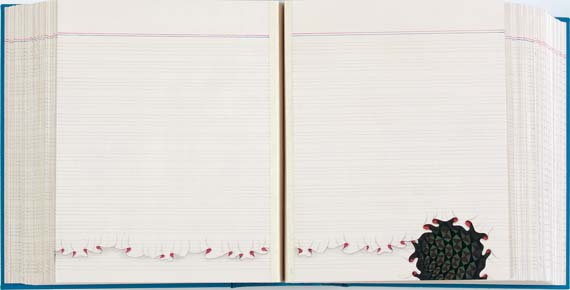
Name, Class, Subject / 2009 / Courtesy of the artist, Corvi-Mora Gallery and Raking Leaves
will show a selection of embroidered cloth banners from a series entitled Les Maitres invisibles (The Invisible Masters, 2008). Koraichi uses Arabic calligraphy and symbols and ciphers from a range of other languages and cultures to explore the lives and legacies of the fourteen great mystics of Islam. The work aims to show that the world of Islam, in contrast to contemporary perceptions of crisis and violence, has another side entirely, evident in the tolerant and sophisticated writings of great Muslim thinkers and poets such as Rumi and El Arabi. These ‘masters’, whose fame has spread even to the West, left an imprint on successive generations and their message is just as relevant today as when first written down. Rachid Koraïchi was born in Algeria and now lives and works between Tunisia and France.
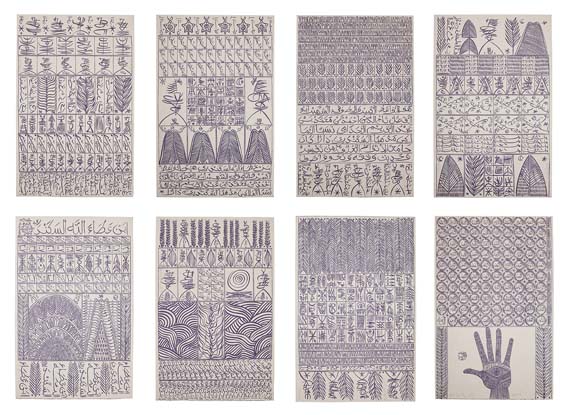
The Invisible Masters / 2008 / Photo by Jonathan Greet, courtesy of October Gallery
will exhibit a sculptural installation made from recycled cardboard, newspaper and glue entitled Bridge (2009). El Mestikawy has created an intricate and geometrical sculpture by reusing equal extracts of Arabic and English newspaper to form seven movable units which can be arranged within the installation to form ‘bridges’. The work is a continuation of his exploration of the socio-political issues of North versus South and East versus West. El Mestikawy defines the
space between different regions, both geographically and metaphorically. His practice assimilates ancient Eygptian and Islamic art and architecture, as well as contemporary and minimal art philosophies. El Mestikawy was born in Egypt and lives and works in between Egypt and Austria.
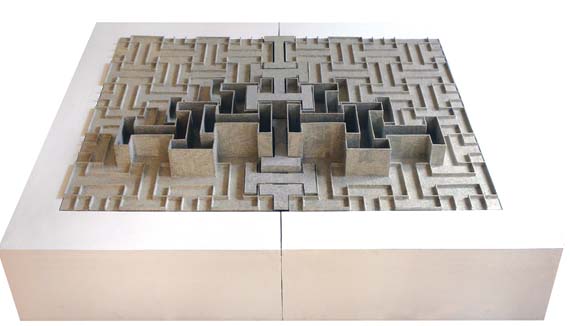
Bridge / 2009 / Courtesy of the artist
will show two new works, 22500 (2011) and 26000 Pages (2011) which are a continuation of her signature paper scroll works. Made up of 22,500 and 26,000 strips of paper, each scroll is marked with printed and hand-written Farsi (Persian) text, then tightly rolled into concentric circles, concealing or revealing different elements of the text. The concentric forms of both text and material take their inspiration from the dance of the whirling dervish. Shafie’s paper scroll works demonstrate a constant element of her work which is the significance of process, repetition and time, all rooted in the influence of Islamic art and craft. Hadieh Shafie was born in Iran and lives and works in the USA.
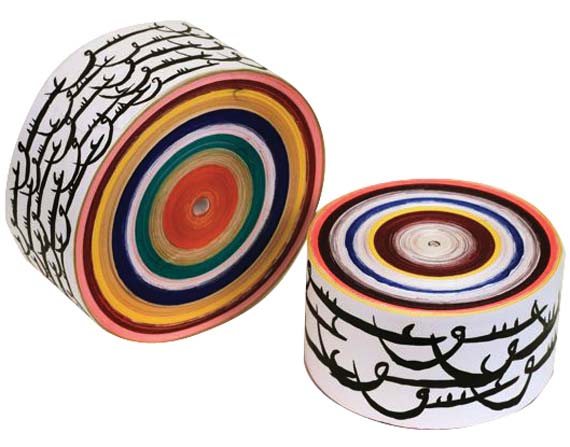
Detail of 22500 / 2011 / Courtesy of the artist
will exhibit two prints Frolicking Women in the Pool (2007) and Fashion Week (2010). Her work often explores the accommodation of modernity within a traditional society, particularly referencing Muslim youth culture in Iran and the United States. In these digital collages from her ‘Maxiature’ series, Sharifi has enlarged scans of traditional Persian miniature paintings and interjected them with her own photographs to create layered narratives which reflect either her
own personal experience or the storyline of the original miniature painting. Soody Sharifi was born in Iran and lives and works in the USA.
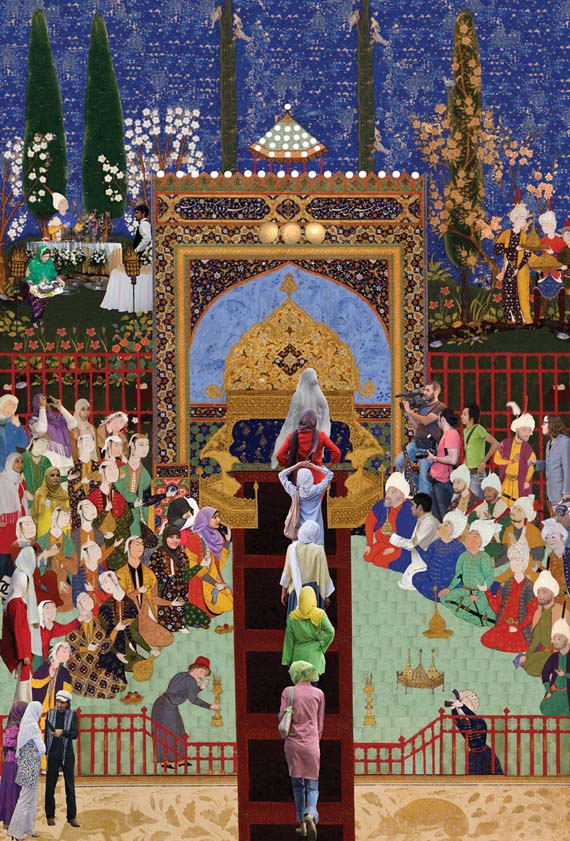
Fashion Week / 2010 / Courtesy of the artist
Comments
Sep 12, 2011 - 9:43:53
I was researching the history of kiswah for an embroidery project I am doing and I found this site. I think all the work is interesting but I particularly like the work of Rachid Koraïchi - both the work itself and the desire for a shared, co-operative living space for all.
I send my best wishes to all the artists.
I hope we can all keep working in peaceful ways towards a fairer and more peaceful world.
Mar 20, 2011 - 18:38:02
Hayv Kahraman is not only a modern artist that submits nice colourful work.She has a message in her heart and soul. She is carrying the wounds and suffering of her country wherever she goes. Her pure solid principles are well sculptured in her drawings. She works for all ages of her country (Iraq). Whatever I say I can’t give her what she worth. If she would not get Jammel’s prize, she has got already the prizes of all the people who have valued and appreciated her work. I wish her success and love of her admirers.
Add a comment